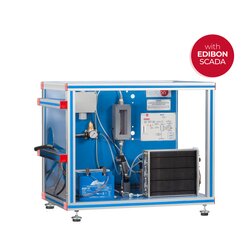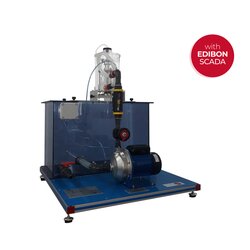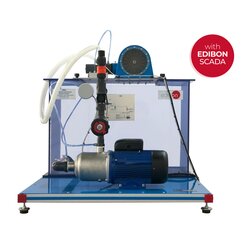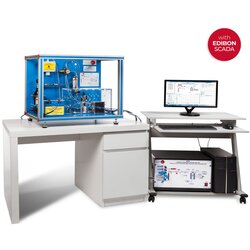Computer Controlled Biogas Process Unit (EBGC)



PL-503847
The Computer Controlled Biogas Process Unit, “EBGC,” by EDIBON is equipped with two packed anaerobic digesters, enabling the user to work in either a single-stage or two-stage configuration, where the different phases of the digestion process are separated. In a two-stage process, the hydrolysis, acidogenesis, and acetogenesis occur in the first digester, while methanogenesis takes place in the second. Each digester is fitted with a heating blanket that allows precise temperature regulation through PID control, providing flexibility for different ranges of operation depending on the microorganisms used. The system can operate within the psychrophilic range (room temperature), mesophilic range (approximately 35°C), or thermophilic range (around 55°C).
The unit includes four computer-controlled peristaltic pumps to control the introduction of the feedstock, acid, and base into the digesters. These pumps also manage the pH control at each stage of the process. When operating in two-stage digestion, one pump transfers the product from one digester to the other, passing through a buffer tank to collect any excess flow from the first reactor. The system’s control of these pumps ensures the accurate monitoring of flow rates throughout the process.
For measuring the biogas produced, two volumetric tanks are included. The biogas flows from the digesters to these tanks, where its volume is measured through water displacement. The tanks are designed with two sections: the upper section collects the biogas, while the smaller lower section collects the displaced water. Each digester is equipped with temperature and pH sensors to monitor the process, helping to assess the impact of different control parameters on anaerobic digestion.
Additionally, the biogas collected in the tanks passes through a methane sensor (CH4), which measures the methane concentration. This allows the quality of the biogas to be assessed based on the physical-chemical conditions during anaerobic digestion, and it helps to determine its potential as a renewable energy source.
The unit is fully integrated with the EDIBON Computer Control System (SCADA), which includes a control interface box, a data acquisition board, and computer control, data acquisition, and data management software for comprehensive monitoring and control of the entire process.
- EBGC. Unit:
- Bench-top unit.
- Anodized aluminum frame and panels made of painted steel.
- Main metallic elements made of stainless steel.
- Diagram in the front panel with distribution of the elements similar to the real one.
- Two packed anaerobic digesters of 5 l. Reactors packing: 25 mm diameter bactoballs.
- Two computer controlled heating blankets of 120 W, with PID control and with a thermostat. Temperature range: 0 – 90 °C.
- Four computer controlled peristaltic pumps.
- Feeding flows measurement by the pumps calibration.
- Two volumetric tanks for the storage and volume measurement of the generated biogas.
- Buffer vessel, of 1 l of capacity.
- Two glass vessels, of 1 l of capacity, for the acid and the base.
- Methane sensor to measure its concentration in the generated biogas, 0 – 100 %.
- Two pH sensors.
- Two “J” type temperature sensors.
The complete unit includes as well:
- Advanced Real-Time SCADA.
- Open Control + Multicontrol + Real-Time Control.
- Specialized EDIBON Control Software based on LabVIEW.
- National Instruments Data Acquisition board.
- Calibration exercises, which are included, teach the user how to calibrate a sensor and the importance of checking the accuracy of the sensors before taking measurements.
- Projector and/or electronic whiteboard compatibility allows the unit to be explained and demonstrated to an entire class at one time.
- Capable of doing applied research, real industrial simulation, training courses, etc.
- Remote operation and control by the user and remote control for EDIBON technical support, are always included.
- Totally safe, utilizing 4 safety systems (Mechanical, Electrical, Electronic and Software).
- Designed and manufactured under several quality standards.
- Optional ICAI software to create, edit and carry out practical exercises, tests, exams, calculations, etc. Apart from monitoring user’s knowledge and progress reached.
- This unit has been designed for future expansion and integration. A common expansion is the EDIBON Scada-Net (ESN) System which enables multiple students to simultaneously operate many units in a network.
- EBGC/CIB. Control Interface Box.
- EBGC/CCSOF. Computer Control + Data Acquisition + Data Management Software.
- Cables and Accessories, for normal operation.
- Manuals: This unit is supplied with 8 manuals. Required services, Assembly and Installation, Interface and Control software, Starting-up, Safety, Maintenance, Calibration and Practices manuals.
EXERCISES AND PRACTICAL POSSIBILITIES TO BE DONE WITH THE MAIN ITEMS
- Study of the stabilization process.
- Study of the effect of temperature in the anaerobic digestion, purification and quality of the obtained biogas.
- Study of the pH effect of the feeding waste water in the anaerobic digestion, purification and quality of the obtained biogas.
- Study of the influence of the feeding rate in the anaerobic digestion, purification and quality of the obtained biogas.
- Study of the influence of the type of the feeding waste water in the anaerobic digestion, purification and quality of the obtained biogas.
- Study of the concentration of nutrients influence of the feeding waste water in the anaerobic digestion, purification and quality of the obtained biogas.
- Study of the hydraulic load effect in the anaerobic digestion, purification and quality of the obtained biogas.
- Study of the inhibitors influence in the anaerobic digestion, purification and quality of the obtained biogas.
- Comparison between the mesophilic and thermophilic anaerobic digestion and their influence in the biogas obtention.
- Determination of the optimum operation temperature.
- Determination of the optimum feeding rate.
- Determination of the optimum solids/water relation.
- Determination of the optimum degradable/non degradable solids relation.
- Determination of the multistage nature in the anaerobic digestion.
- Determination of the kinetics.
- Carbon balance.
- Solids balance.
- Biogas balance.
- Sensors calibration.
What is this?
These percentage scores are an average of 0 user reviews. To get more into detail, see each review and comments as per below
If you have used this product, support the community by submitting your review



